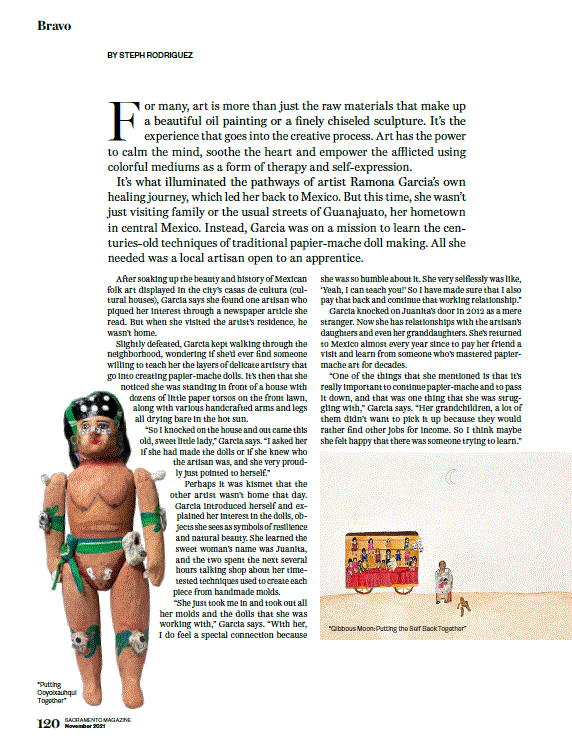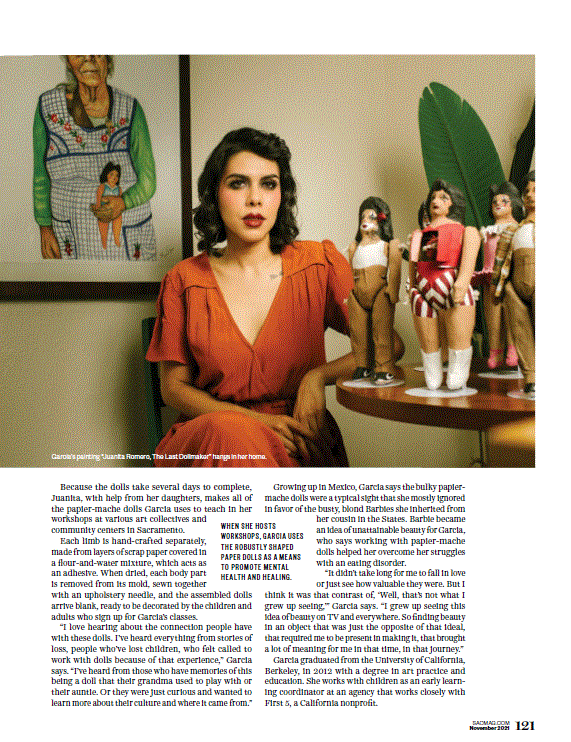It was an honor to have been interviewed for the November issue of Sacmag. The author, Stephanie Rodriguez did such an exquisite job in capturing the essence of my work with the paper-mache doll.
Find screenshots to the entire interview below.
Your Custom Text Here
It was an honor to have been interviewed for the November issue of Sacmag. The author, Stephanie Rodriguez did such an exquisite job in capturing the essence of my work with the paper-mache doll.
Find screenshots to the entire interview below.




"las cosas tienen vida propia todo esta en despertarles el ánima//things (objetcs) have their own life all we have to do is wake up their souls"
- Malquiades, 100 Años de Soledad/ 100 Years of Solitude
I dont remember the first time I heard the tale of la Llorona but I remember being scared as hell by it. Everyone who’s been raised in a latino household has come to this story in one or another way. One of the earliest Mexica legends has it that the story was inspired by Emperor Moctezuma’s sister and the women’s sadness for the loss of sons and brothers in the battle against the Spanish. Whatever the setting, the story is almost always the same. And there’s been soooo many interpretations that my version can be just as good or bad as it gets but I know for fact that we have all been lloronas at some point of our lives. We’ve all shed tears hoping that our dolorcitos go away. I really dont think crying is an act of weakness. Actually most of the time it isnt. If it can cause such a comossion that it forces part of our bodies to burst out from within it has to be a sentimiento much much more powerful than that. it doesnt just serve a physiological function u silly
I rewrote the story a year ago inspired by my aunt Lupe… except Tia Lupe wasnt abandoned by her husband. She became a widow 2 months after her first child was born. When her baby turned 3 yrs she decided to leave Mexico to come work in CA. When she stayed with us (about 12 years ago!) la llorona would often visit at night and it made me wonder if it was her way of traveling back to her baby
Truth is.. tears are magical things. They cleanse, they connect us… they are the beginning of the cure. Crying in public was even considered normal until the industrial revolution, when diligent unemotional workers were needed to operate machinery. Lloronas these days have a lot more crying to do. We hear them all the time but we are so used to running away from them that we ignore their purpose and message. They cry behind a closed door, inside a closet, in the churches, the fields, las maquilas, the classrooms, manifestaciones …in the sudden piquetito of tristeza que queda cuando el amor que creiamos verdadero se va. I couldnt figure out the rest of the film when I first storyboarded it but i can hear her calling again…the second part sloooowly coming together

My cousin Alexis and I.

At my nana’s house during my first visit to the U.S. for dad’s work season.
When I was about 6 years old and spending the summer with my family in California, my cousin Alexis gave me a box full of Barbies. For her, it must have been all of her throwaways, old and semi new blond haired barbie dolls with piercing blue eyes, a couple of ginger ones and two or three Kens. I assume she no longer deemed them beautiful or worthy to play with since her room overflowed with far more toys and barbies than I had ever seen in the aisles of Walmart. For me, the box was a treasure. An unbelievable gift. I carried the dolls everywhere I went and when the season of work was over for my Dad, I brought them back to Mexico with us. They were a hit with other little girls at my school. Nobody else in my school had a Barbie, at least not the original ones with the Mattel label printed on the back of the head. Well into my puberty and up until the point where playing with dolls is deemed uncool, these dolls were my best friends, my fierce companions, and a reminder of the United States- that place where you can have it all, all the toys in the world just like my cousin Alexis. Years later, my family and I would end up moving to the States permanently and I would have to learn that having it all meant there is a price to pay for it, sometimes monetary most often, spiritual. As an adult woman with a background in Art & Early Childhood Development, I am able to reflect back on how the dolls became a significant play object that indefinitely shaped my identity as a little brown girl and eventually, my ideas of what women should aspire to be and look like. The endeavor to understand, heal and repair this has taken many forms, from visits to therapists all throughout my young adult life, to pursuing an education in Early Development to an art project that has evolved into working with a dear and loving play object: The Mexican paper-mache doll. The topic of dolls as play objects is intriguing as it is compelling and important. Finding beauty in the object of my craft- just like in life- has allowed me to turn this early experience around and use the paper-mache doll as an empowering emblem and a powerful educational tool. During my current practice, I get to create and share this beautiful craft with other folks, particularly young ones. This enchanting doll remembered by generations of our tias and abuelitas is like a blank canvas. Literally, a piece of paper molded into the form of a doll to re-write and paint a new vision. This doll feels more personal and precise. She is flawed yet beautiful, mundane yet of an incredible cultural value, fragile and temporary yet timeless. The magic that these dolls possess happen, perhaps, as people engage with them to create an object of beauty. Artistic ability or not- the opportunities to create and invent are vast and the process, magical as are they.

Molde de Muñeca. Photography by Andres Alvarez.